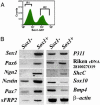Screening for mammalian neural genes via fluorescence-activated cell sorter purification of neural precursors from Sox1-gfp knock-in mice
- PMID: 12923295
- PMCID: PMC304095
- DOI: 10.1073/pnas.1734197100
Screening for mammalian neural genes via fluorescence-activated cell sorter purification of neural precursors from Sox1-gfp knock-in mice
Abstract
The transcription factor Sox1 is the earliest and most specific known marker for mammalian neural progenitors. During fetal development, Sox1 is expressed by proliferating progenitor cells throughout the central nervous system and in no tissue but the lens. We generated a reporter mouse line in which egfp is inserted into the Sox1 locus. Sox1GFP animals faithfully recapitulate the expression of the endogenous gene. We have used the GFP reporter to purify neuroepithelial cells by fluorescence-activated cell sorting from embryonic day 10.5 embryos. RNAs prepared from Sox1GFP+ and Sox1GFP- embryo cells were then used to perform a pilot screen of subtracted cDNAs prepared from differentiating embryonic stem cells and arrayed on a glass chip. Fifteen unique differentially expressed genes were identified, all previously associated with fetal or adult neural tissue. Whole mount in situ hybridization against two genes of previously unknown embryonic expression, Lrrn1 and Musashi2, confirmed the selectivity of this screen for early neuroectodermal markers.
Figures



References
-
- Rossi, F. & Cattaneo, E. (2002) Nat. Rev. Neurosci. 3, 401-409. - PubMed
-
- Gorba, T. & Allsopp, T. (2003) Pharmacol. Res. 47, 269-278. - PubMed
-
- Svendsen, C. N. & Smith, A. G. (1999) Trends Neurosci. 22, 357-364. - PubMed
-
- Evans, M. J. & Kaufman, M. H. (1981) Nature 292, 154-156. - PubMed
-
- Doetschman, T. C., Eistetter, H., Katz, M., Schmidt, W. & Kemler, R. (1985) J. Embryol. Exp. Morphol. 87, 27-45. - PubMed
Publication types
MeSH terms
Substances
Grants and funding
LinkOut - more resources
Full Text Sources
Other Literature Sources
Medical
Molecular Biology Databases

